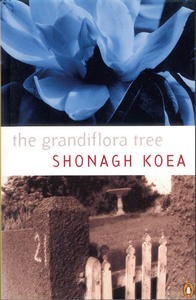Reading Older Books: “The Grandiflora Tree” by Shonagh Koea
As mentioned on November 22, it was May 17 when I commenced this Reading Older Book series, with the promise of reporting back to you on four older books.
Today it’s the turn of the fourth and last book mentioned that day, The Grandiflora Tree by fellow NZ author, Shonagh Koea.
First published in 1989, The Grandiflora Tree was also Shonagh Koea’s first novel, although it followed a collection of short stories (1987.)

The Grandiflora Tree is very much what I think of as “personal” fiction. I definitely don’t mean that it is memoir thinly disguised as fiction, but the story is very much focused in the point-of-view of one character. The narrative also centres on personal, or even intimate, events in the life of that character. And very often (although not always), events in the public life of the society in question, however significant, do not intrude upon the story.
In this case, the main character, Bernadette Crichton, suffers the sudden and unexpected death of her older husband, Charlie. The novel explores Bernadette’s grief, encompassing both her bereavement and the reactions of friends and family.
If a response to trauma must necessarily fall between the three options of flight-fight-freeze, Bernadette charts a course between freezing, almost literally in the immediate aftermath of Charlie’s death, and a subsequent prolonged “flight” from herself and others. This flight is both physical and emotional: she literally and emotionally retreats from the world and engagement with others through a long process of turning inward.

Original cover
The Grandiflora Tree is a beautifully written study of grief, and I believe anyone who has experienced grief will appreciate the author’s wry observation upon the inability, or reluctance, of many people to empathise or engage with the bereaved.
The second part of the narrative, running in parallel with the account of Bernadette’s grief, concerns her discovery of diaries and letters that provide insight into Charlie’s younger life and character. I found this second narrative thread less satisfying, particularly in terms of its place in Bernadette’s arc. It seemed a little contrived, perhaps as a way of expanding the story to novel length, but I felt the illumination of Charlie’s character, and deepening of Bernadette’s arc thereby, could have been encompassed in considerably less text.
The Grandiflora Tree provides an indepth character study of Bernadette, as well as a portrayal of grief, and in both these respects I enjoyed the read. If the accompanying narrative comprises a delicate, if not slender, thread, that is frequently the case with “personal” fiction—but should be borne in mind by readers who prefer a ripping yarn and/or fast-paced storytelling.
However, if you enjoyed John Banville’s The Sea, Muriel Barbery’s The Elegance of the Hedgehog, or Emily Maguire’s Smoke In The Room, then The Grandiflora Tree could well appeal.
By way of disclosure, I read the 1989 paperback edition, 192 pp, published by Penguin, which I acquired second hand.










